2013 MERCEDES-BENZ G-CLASS SUV air condition
[x] Cancel search: air conditionPage 6 of 364
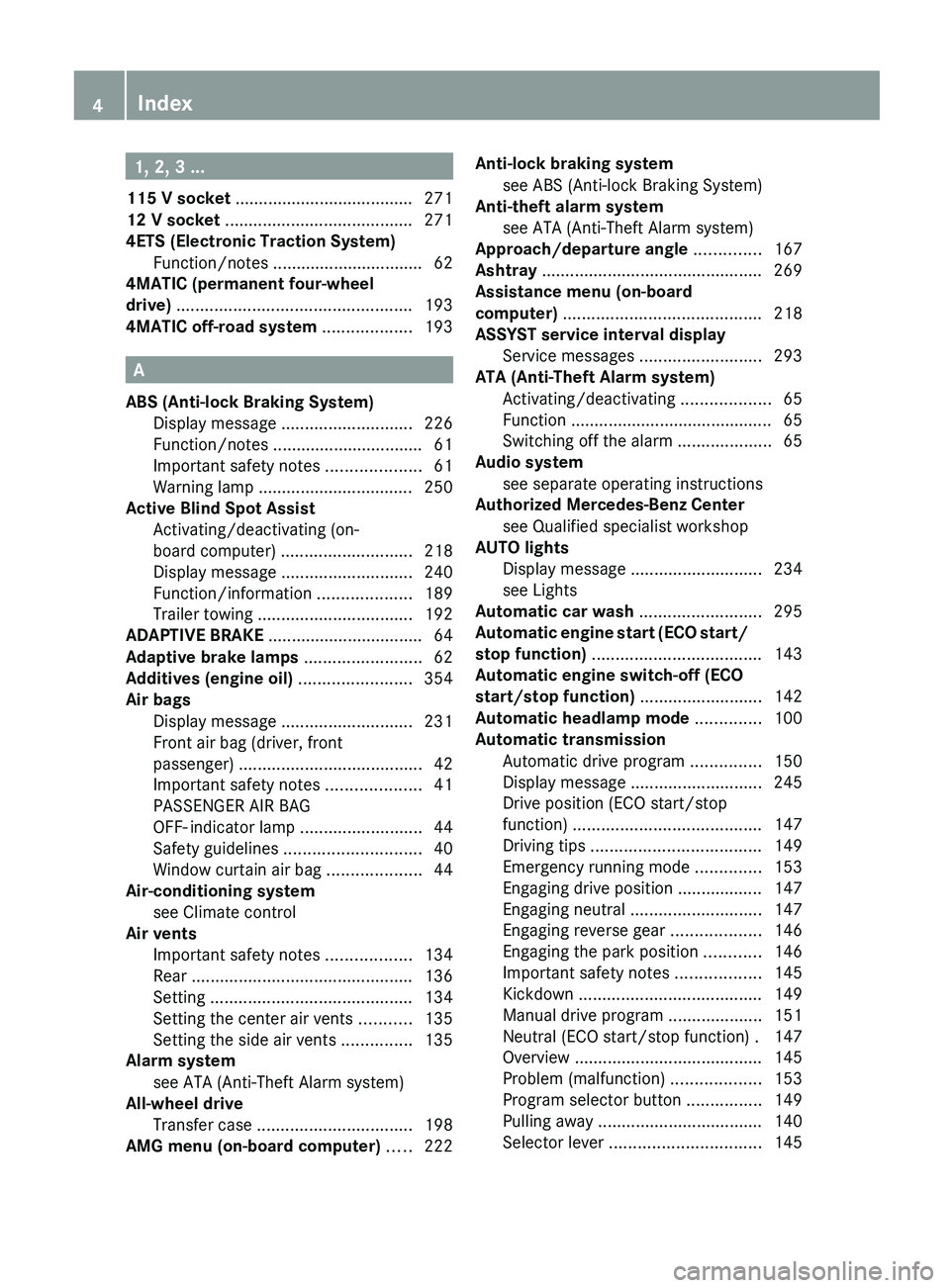
1, 2, 3 ...
115 V socket ...................................... 271
12 V socket ........................................ 271
4ETS (Electronic Traction System) Function/notes ................................
62
4MATIC (permanent four-wheel
drive) .................................................. 193
4MATIC off-road system ................... 193A
ABS (Anti-lock Braking System) Display message ............................ 226
Function/notes ................................ 61
Important safety notes
....................61
Warning lamp ................................. 250
Active Blind Spot Assist
Activating/deactivating (on-
board computer) ............................ 218
Display message ............................ 240
Function/information .................... 189
Trailer towing ................................. 192
ADAPTIVE BRAKE ................................. 64
Adaptive brake lamps .........................62
Additives (engine oil) ........................354
Air bags Display message ............................ 231
Front air bag (driver, front
passenger) ....................................... 42
Important safety notes .................... 41
PASSENGER AIR BAG
OFF- indicator lamp .......................... 44
Safety guidelines ............................. 40
Window curtain air bag ....................44
Air-conditioning system
see Climate control
Air vents
Important safety notes .................. 134
Rear ............................................... 136
Setting ........................................... 134
Setting the center air vents ...........135
Setting the side air vents ............... 135
Alarm system
see ATA (Anti-Theft Alarm system)
All-wheel drive
Transfer case ................................. 198
AMG menu (on-board computer) ..... 222Anti-lock braking system
see ABS (Anti-lock Braking System)
Anti-theft alarm system
see ATA (Anti-Theft Alarm system)
Approach/departure angle ..............167
Ashtray ............................................... 269
Assistance menu (on-board
computer) .......................................... 218
ASSYST service interval display Service messages .......................... 293
ATA (Anti-Theft Alarm system)
Activating/deactivating ................... 65
Function ........................................... 65
Switching off the alarm .................... 65
Audio system
see separate operating instructions
Authorized Mercedes-Benz Center
see Qualified specialist workshop
AUTO lights
Display message ............................ 234
see Lights
Automatic car wash .......................... 295
Automatic engine start (ECO start/
stop function) .................................... 143
Automatic engine switch-off (ECO
start/stop function) .......................... 142
Automatic headlamp mode ..............100
Automatic transmission Automatic drive program ............... 150
Display message ............................ 245
Drive position (ECO start/stop
function) ........................................ 147
Driving tips .................................... 149
Emergency running mode ..............153
Engaging drive position .................. 147
Engaging neutral ............................ 147
Engaging reverse gear ................... 146
Engaging the park position ............ 146
Important safety notes .................. 145
Kickdown ....................................... 149
Manual drive program ....................151
Neutral (ECO start/stop function) . 147
Overview ........................................ 145
Problem (malfunction) ...................153
Program selector button ................149
Pulling away ................................... 140
Selector lever ................................ 1454
Index
Page 16 of 364

Remote control
Programming (garage door
opener) .......................................... 281
Reporting safety defects .................... 24
Reserve (fuel tank) see Fuel
Reserve fuel
Display message ............................ 237
Warning lamp ................................. 256
see Fuel
Residual heat
Switching on/off ........................... 134
Restraint systems
see SRS (Supplemental Restraint
System)
Reversing lamps (display
message) ............................................ 233
Roadside Assistance (breakdown) ....22
Roof lining and carpets (cleaning
guidelines) ......................................... 300
Route (navigation) see Route guidance (navigation)
Route guidance (navigation) ............214S
Safety Children in the vehicle .....................54
Child restraint systems ....................54
Safety system
see Driving safety systems
Seat backrest
Folding back .................................. 265
Seat belts
Adjusting the height ......................... 52
Belt force limiters ............................ 53
Cleaning ......................................... 300
Correct usage .................................. 49
Emergency Tensioning Devices ........ 53
Fastening ......................................... 50
Fastening, front ............................... 51
Fastening in the rear, center ............51
Important safety guidelines .............48
Releasing ......................................... 52
Safety guidelines ............................. 40
Special seat belt retractor ............... 56
Warning lamp ................................. 248
Warning lamp (function) ................... 53 Seat heating
Indicator lamp (malfunction) ............ 90
Seats
Adjusting (electrically) .....................86
Adjusting the 4-way lumbar
support ............................................ 89
Adjusting the head restraint ............ 86
Cleaning the cover .........................299
Correct driver's seat position ...........
84
Important safety notes .................... 85
Overview .......................................... 85
Storing settings (memory
function) .......................................... 95
Switching seat heating on/off ......... 89
Switching seat ventilation on/off ....90
Seat ventilation
Indicator lamp (malfunction) ............ 90
Sensors (cleaning instructions) .......297
Service interval display Displaying a service message (on-
board computer) ............................ 293
Service menu (on-board computer) . 218
Service products Brake fluid ..................................... 354
Coolant (engine) ............................ 354
Engine oil ....................................... 353
Fuel ................................................ 350
Important safety notes .................. 350
Notes ............................................. 350
Refrigerant (air-conditioning
system) .......................................... 354
Washer fluid ................................... 356
Setting a speed limit
see SPEEDTRONIC
Settings
Calling up a stored setting ............... 96
Factory (on-board computer) ......... 222
On-board computer ....................... 218
Setting the air distribution ...............131
SETUP (on-board computer) ............. 222
Shift ranges ....................................... 150
Side marker lamp (display
message) ............................................ 233
Side marker lamps (changing
bulbs) ................................................. 11214
Index
Page 25 of 364
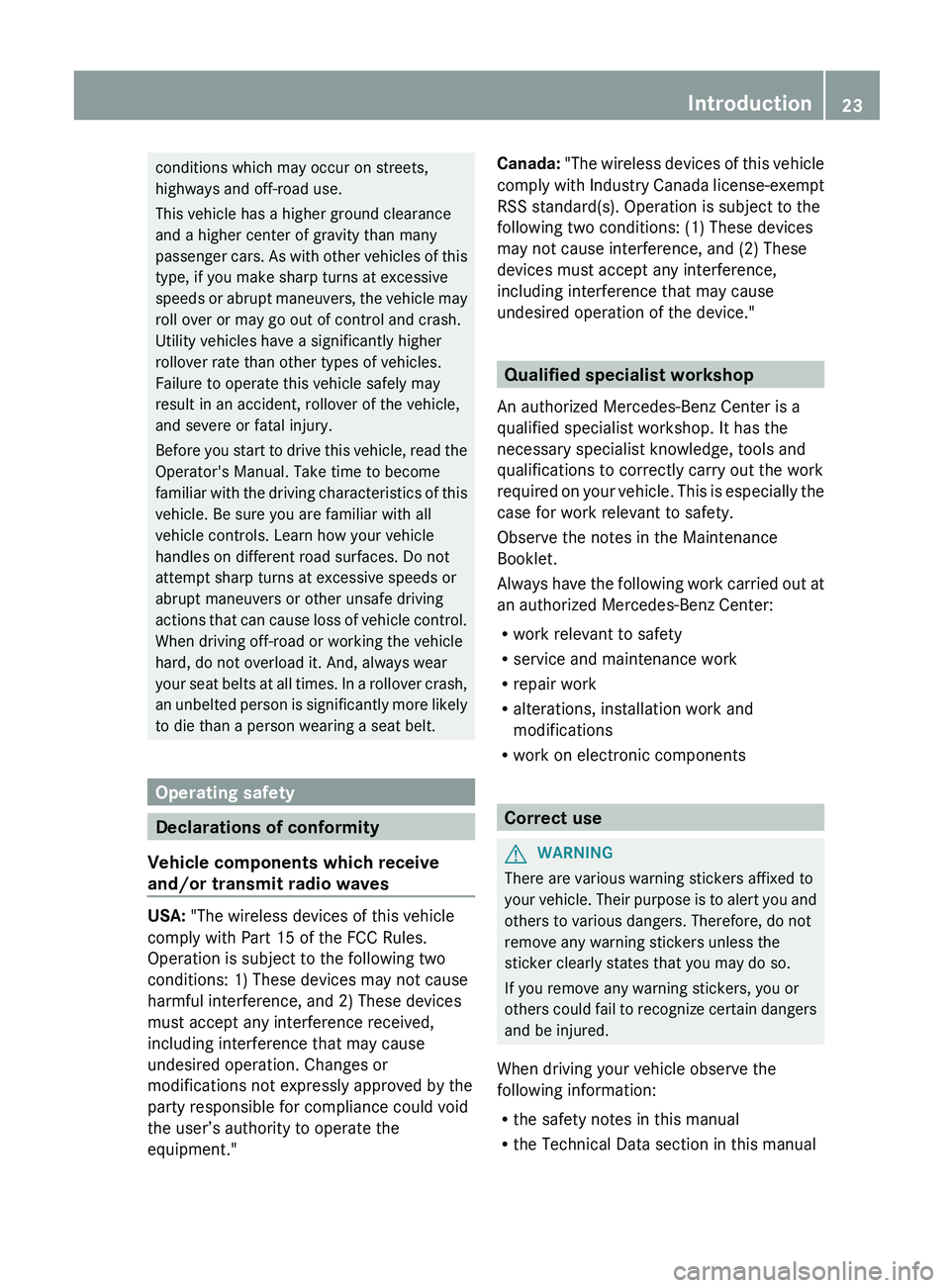
conditions which may occur on streets,
highways and off-road use.
This vehicle has a higher ground clearance
and a higher center of gravity than many
passenger cars. As
with
other vehicles of this
type, if you make sharp turns at excessive
speeds or abrupt maneuvers, the vehicle may
roll over or may go out of control and crash.
Utility vehicles have a significantly higher
rollover rate than other types of vehicles.
Failure to operate this vehicle safely may
result in an accident, rollover of the vehicle,
and severe or fatal injury.
Before you start to drive this vehicle, read the
Operator's Manual. Take time to become
familiar with the driving characteristics of this
vehicle. Be sure you are familiar with all
vehicle controls. Learn how your vehicle
handles on different road surfaces. Do not
attempt sharp turns at excessive speeds or
abrupt maneuvers or other unsafe driving
actions that can cause loss of vehicle control.
When driving off-road or working the vehicle
hard, do not overload it. And, always wear
your seat belts at all times. In a rollover crash,
an unbelted person is significantly more likely
to die than a person wearing a seat belt. Operating safety
Declarations of conformity
Vehicle components which receive
and/or transmit radio waves USA: "The wireless devices of this vehicle
comply with Part 15 of the FCC Rules.
Operation is subject to the following two
conditions: 1) These devices may not cause
harmful interference, and 2) These devices
must accept any interference received,
including interference that may cause
undesired operation. Changes or
modifications not expressly approved by the
party responsible for compliance could void
the user’s authority to operate the
equipment." Canada:
"The wireless devices of this vehicle
comply with Industry
Canada license-exempt
RSS standard(s). Operation is subject to the
following two conditions: (1) These devices
may not cause interference, and (2) These
devices must accept any interference,
including interference that may cause
undesired operation of the device." Qualified specialist workshop
An authorized Mercedes-Benz Center is a
qualified specialist workshop. It has the
necessary specialist knowledge, tools and
qualifications to correctly carry out the work
required on your vehicle.
This is especially the
case for work relevant to safety.
Observe the notes in the Maintenance
Booklet.
Always have the following work carried out at
an authorized Mercedes-Benz Center:
R work relevant to safety
R service and maintenance work
R repair work
R alterations, installation work and
modifications
R work on electronic components Correct use
G
WARNING
There are various warning stickers affixed to
your vehicle. Their purpose
is to alert you and
others to various dangers. Therefore, do not
remove any warning stickers unless the
sticker clearly states that you may do so.
If you remove any warning stickers, you or
others could fail to recognize certain dangers
and be injured.
When driving your vehicle observe the
following information:
R the safety notes in this manual
R the Technical Data section in this manual Introduction
23 Z
Page 40 of 364
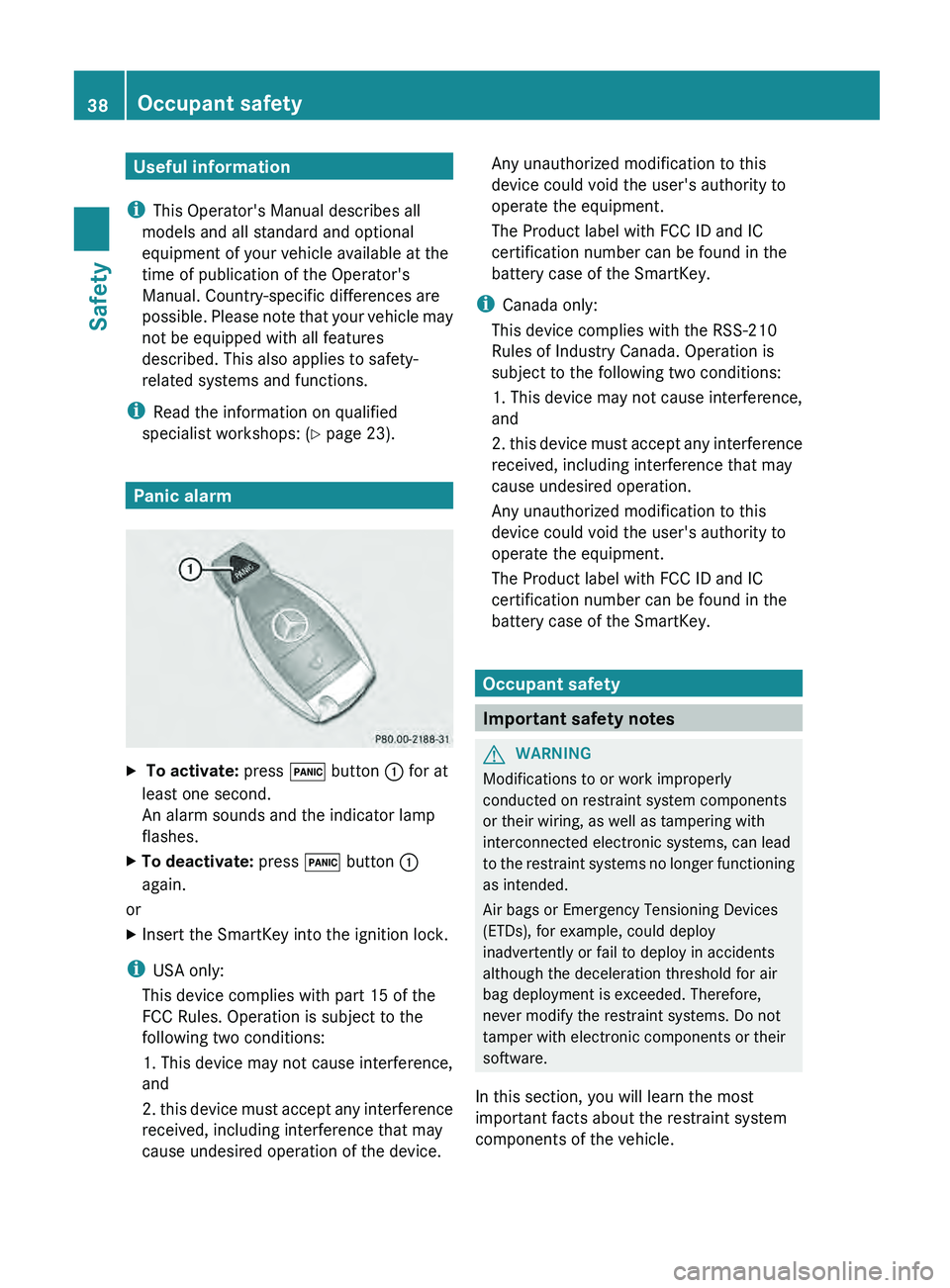
Useful information
i This Operator's Manual describes all
models and all standard and optional
equipment of your vehicle available at the
time of publication of the Operator's
Manual. Country-specific differences are
possible. Please note that
your vehicle may
not be equipped with all features
described. This also applies to safety-
related systems and functions.
i Read the information on qualified
specialist workshops: ( Y page 23).Panic alarm
X
To activate: press 0033 button 0043 for at
least one second.
An alarm sounds and the indicator lamp
flashes.
X To deactivate: press 0033 button 0043
again.
or
X Insert the SmartKey into the ignition lock.
i USA only:
This device complies with part 15 of the
FCC Rules. Operation is subject to the
following two conditions:
1. This device may not cause interference,
and
2. this device
must accept any interference
received, including interference that may
cause undesired operation of the device. Any unauthorized modification to this
device could void the user's authority to
operate the equipment.
The Product label with FCC ID and IC
certification number can be found in the
battery case of the SmartKey.
i Canada only:
This device complies with the RSS-210
Rules of Industry Canada. Operation is
subject to the following two conditions:
1. This device may not cause interference,
and
2. this device must
accept any interference
received, including interference that may
cause undesired operation.
Any unauthorized modification to this
device could void the user's authority to
operate the equipment.
The Product label with FCC ID and IC
certification number can be found in the
battery case of the SmartKey. Occupant safety
Important safety notes
G
WARNING
Modifications to or work improperly
conducted on restraint system components
or their wiring, as well as tampering with
interconnected electronic systems, can lead
to the restraint systems
no longer functioning
as intended.
Air bags or Emergency Tensioning Devices
(ETDs), for example, could deploy
inadvertently or fail to deploy in accidents
although the deceleration threshold for air
bag deployment is exceeded. Therefore,
never modify the restraint systems. Do not
tamper with electronic components or their
software.
In this section, you will learn the most
important facts about the restraint system
components of the vehicle. 38
Occupant safety
Safety
Page 63 of 364
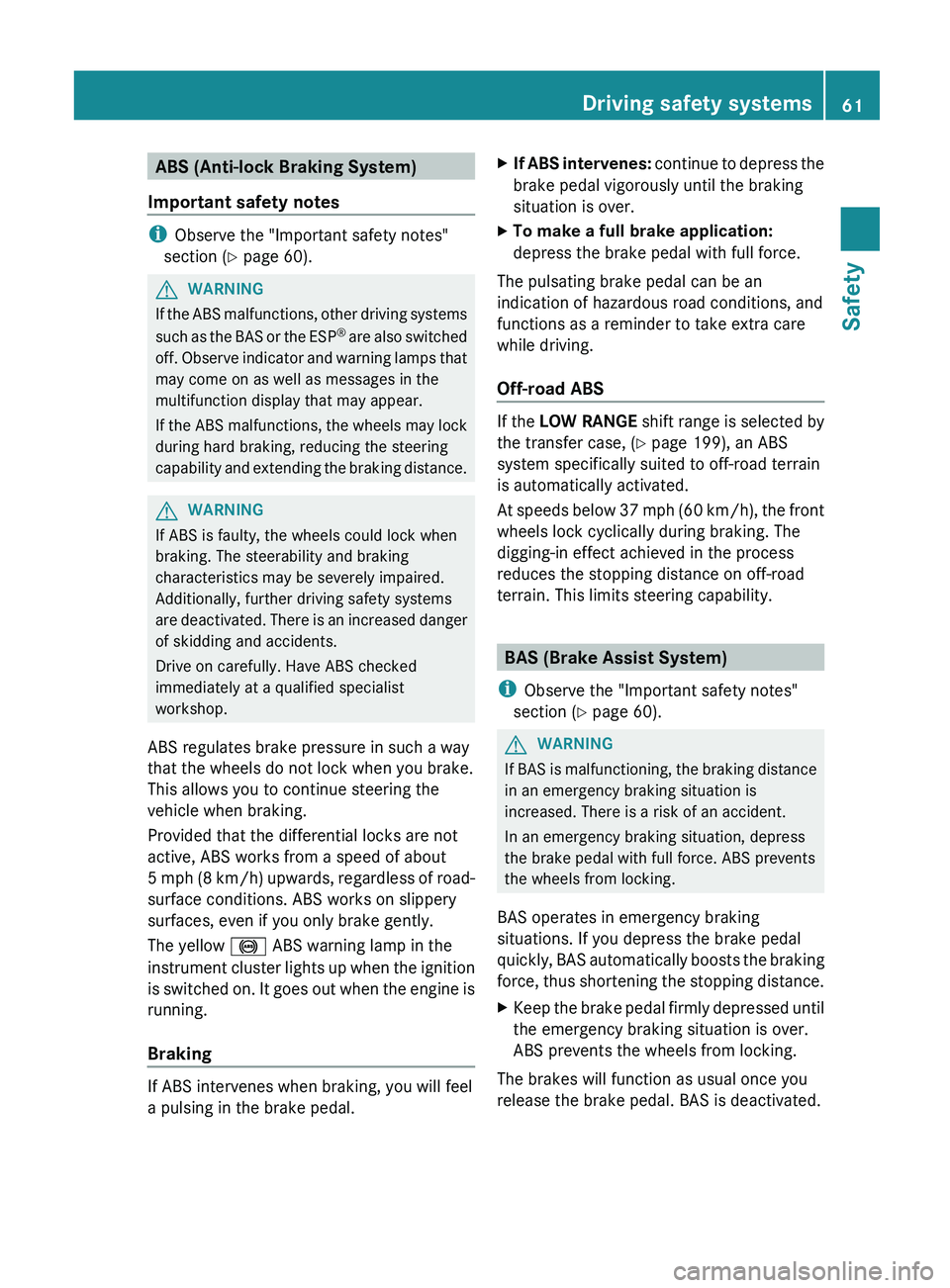
ABS (Anti-lock Braking System)
Important safety notes i
Observe the "Important safety notes"
section ( Y page 60). G
WARNING
If the ABS malfunctions, other driving systems
such as the BAS
or the ESP®
are also switched
off. Observe indicator and warning lamps that
may come on as well as messages in the
multifunction display that may appear.
If the ABS malfunctions, the wheels may lock
during hard braking, reducing the steering
capability and extending the braking distance. G
WARNING
If ABS is faulty, the wheels could lock when
braking. The steerability and braking
characteristics may be severely impaired.
Additionally, further driving safety systems
are deactivated. There
is
an increased danger
of skidding and accidents.
Drive on carefully. Have ABS checked
immediately at a qualified specialist
workshop.
ABS regulates brake pressure in such a way
that the wheels do not lock when you brake.
This allows you to continue steering the
vehicle when braking.
Provided that the differential locks are not
active, ABS works from a speed of about
5 mph (8 km/h) upwards, regardless of road-
surface conditions. ABS works on slippery
surfaces, even if you only brake gently.
The yellow 0025 ABS warning lamp in the
instrument cluster lights up when the ignition
is switched on. It goes out when the engine is
running.
Braking If ABS intervenes when braking, you will feel
a pulsing in the brake pedal. X
If ABS intervenes: continue to depress
the
brake pedal vigorously until the braking
situation is over.
X To make a full brake application:
depress the brake pedal with full force.
The pulsating brake pedal can be an
indication of hazardous road conditions, and
functions as a reminder to take extra care
while driving.
Off-road ABS If the
LOW RANGE shift range is
selected by
the transfer case, (Y page 199), an ABS
system specifically suited to off-road terrain
is automatically activated.
At speeds below 37 mph (60 km/h), the front
wheels lock cyclically during braking. The
digging-in effect achieved in the process
reduces the stopping distance on off-road
terrain. This limits steering capability. BAS (Brake Assist System)
i Observe the "Important safety notes"
section ( Y page 60). G
WARNING
If BAS is malfunctioning, the braking distance
in an emergency braking situation is
increased. There is a risk of an accident.
In an emergency braking situation, depress
the brake pedal with full force. ABS prevents
the wheels from locking.
BAS operates in emergency braking
situations. If you depress the brake pedal
quickly, BAS automatically boosts
the braking
force, thus shortening the stopping distance.
X Keep the brake pedal firmly depressed until
the emergency braking situation is over.
ABS prevents the wheels from locking.
The brakes will function as usual once you
release the brake pedal. BAS is deactivated. Driving safety systems
61
Safety Z
Page 86 of 364
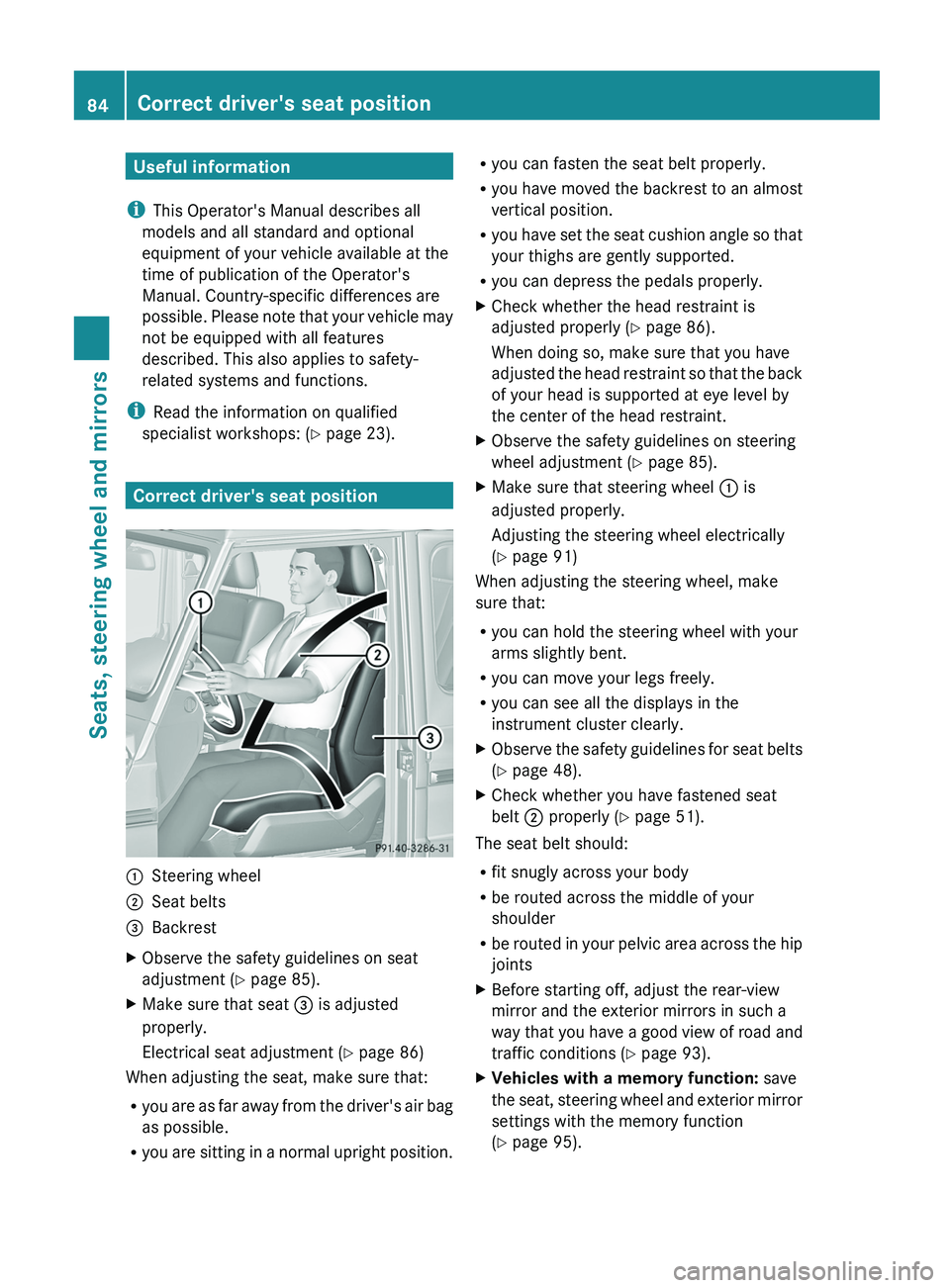
Useful information
i This Operator's Manual describes all
models and all standard and optional
equipment of your vehicle available at the
time of publication of the Operator's
Manual. Country-specific differences are
possible. Please note that
your vehicle may
not be equipped with all features
described. This also applies to safety-
related systems and functions.
i Read the information on qualified
specialist workshops: ( Y page 23).Correct driver's seat position
0043
Steering wheel
0044 Seat belts
0087 Backrest
X Observe the safety guidelines on seat
adjustment ( Y page 85).
X Make sure that seat 0087 is adjusted
properly.
Electrical seat adjustment ( Y page 86)
When adjusting the seat, make sure that:
R you are as far
away from the driver's air bag
as possible.
R you are sitting in a normal upright position. R
you can fasten the seat belt properly.
R you have moved the
backrest to an almost
vertical position.
R you have set the seat cushion angle so that
your thighs are gently supported.
R you can depress the pedals properly.
X Check whether the head restraint is
adjusted properly ( Y page 86).
When doing so, make sure that you have
adjusted the
head restraint so that the back
of your head is supported at eye level by
the center of the head restraint.
X Observe the safety guidelines on steering
wheel adjustment ( Y page 85).
X Make sure that steering wheel 0043 is
adjusted properly.
Adjusting the steering wheel electrically
(Y page 91)
When adjusting the steering wheel, make
sure that:
R you can hold the steering wheel with your
arms slightly bent.
R you can move your legs freely.
R you can see all the displays in the
instrument cluster clearly.
X Observe the safety guidelines for seat belts
(Y page 48).
X Check whether you have fastened seat
belt 0044 properly ( Y page 51).
The seat belt should:
R fit snugly across your body
R be routed across the middle of your
shoulder
R be routed in your
pelvic area across the hip
joints
X Before starting off, adjust the rear-view
mirror and the exterior mirrors in such a
way that you have
a good view of road and
traffic conditions (Y page 93).
X Vehicles with a memory function: save
the seat, steering wheel
and exterior mirror
settings with the memory function
(Y page 95). 84
Correct driver's seat position
Seats, steering wheel and mirrors
Page 120 of 364
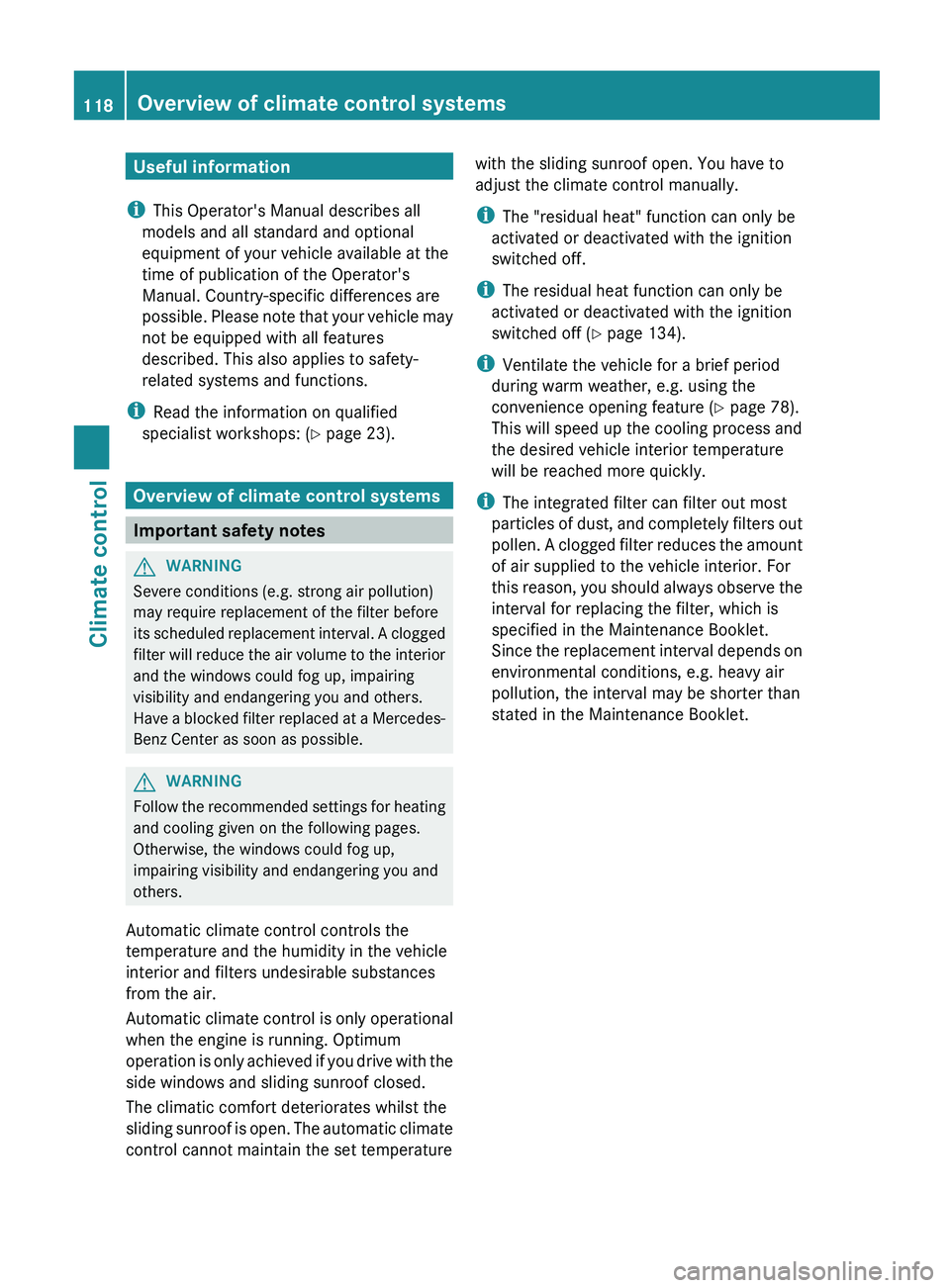
Useful information
i This Operator's Manual describes all
models and all standard and optional
equipment of your vehicle available at the
time of publication of the Operator's
Manual. Country-specific differences are
possible. Please note that
your vehicle may
not be equipped with all features
described. This also applies to safety-
related systems and functions.
i Read the information on qualified
specialist workshops: ( Y page 23).Overview of climate control systems
Important safety notes
G
WARNING
Severe conditions (e.g. strong air pollution)
may require replacement of the filter before
its scheduled replacement interval.
A clogged
filter will reduce the air volume to the interior
and the windows could fog up, impairing
visibility and endangering you and others.
Have a blocked filter replaced at a Mercedes-
Benz Center as soon as possible. G
WARNING
Follow the recommended settings for heating
and cooling given on the following pages.
Otherwise, the windows could fog up,
impairing visibility and endangering you and
others.
Automatic climate control controls the
temperature and the humidity in the vehicle
interior and filters undesirable substances
from the air.
Automatic climate control is
only operational
when the engine is running. Optimum
operation is only achieved if you drive with the
side windows and sliding sunroof closed.
The climatic comfort deteriorates whilst the
sliding sunroof is open. The automatic climate
control cannot maintain the set temperature with the sliding sunroof open. You have to
adjust the climate control manually.
i
The "residual heat" function can only be
activated or deactivated with the ignition
switched off.
i The residual heat function can only be
activated or deactivated with the ignition
switched off (Y page 134).
i Ventilate the vehicle for a brief period
during warm weather, e.g. using the
convenience opening feature ( Y page 78).
This will speed up the cooling process and
the desired vehicle interior temperature
will be reached more quickly.
i The integrated filter can filter out most
particles of dust, and
completely filters out
pollen. A clogged filter reduces the amount
of air supplied to the vehicle interior. For
this reason, you should always observe the
interval for replacing the filter, which is
specified in the Maintenance Booklet.
Since the replacement interval depends on
environmental conditions, e.g. heavy air
pollution, the interval may be shorter than
stated in the Maintenance Booklet. 118
Overview of climate control systems
Climate control
Page 123 of 364
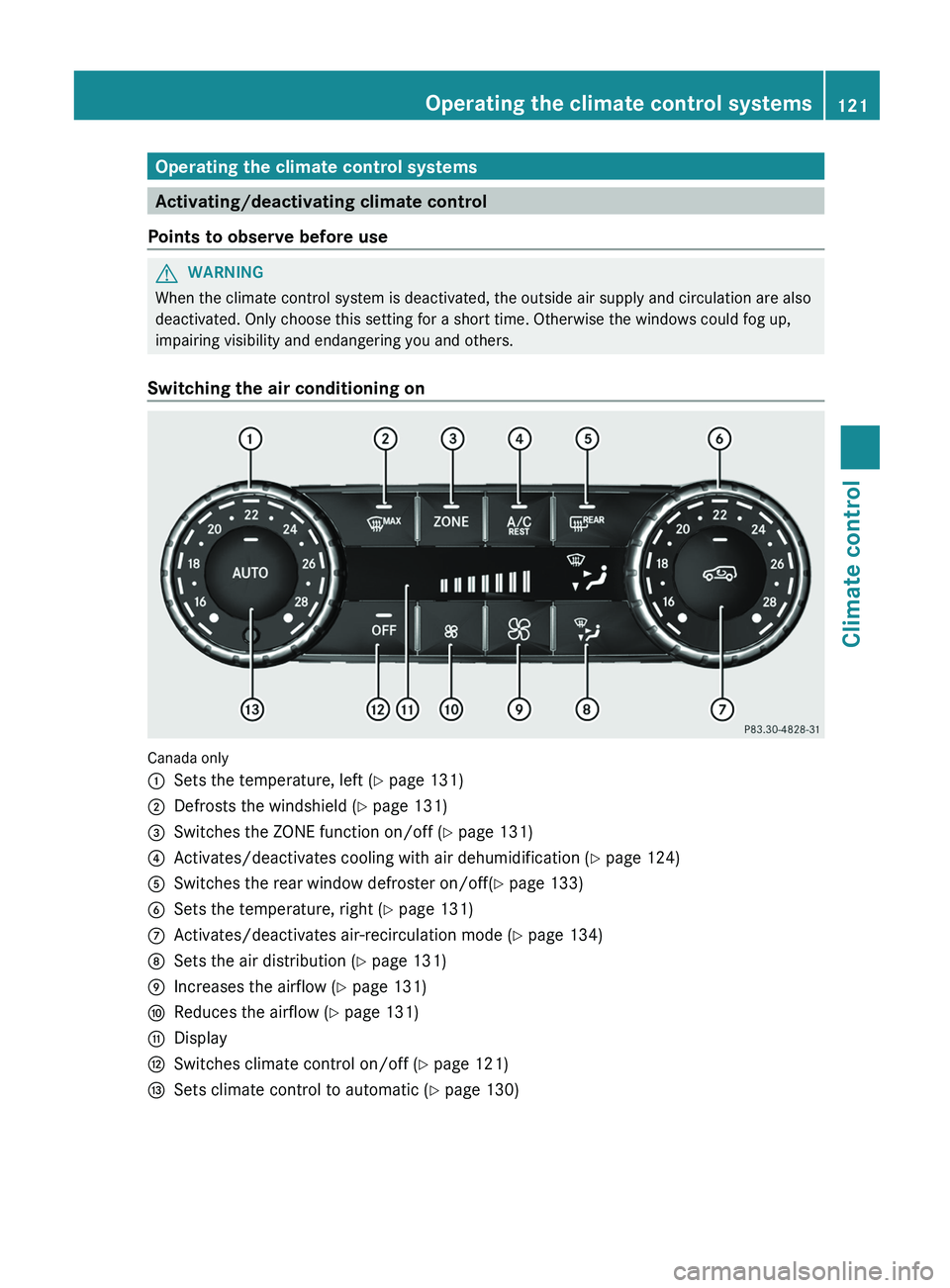
Operating the climate control systems
Activating/deactivating climate control
Points to observe before use G
WARNING
When the climate control system is deactivated, the outside air supply and circulation are also
deactivated. Only choose this setting for a short time. Otherwise the windows could fog up,
impairing visibility and endangering you and others.
Switching the air conditioning on Canada only
0043
Sets the temperature, left ( Y page 131)
0044 Defrosts the windshield ( Y page 131)
0087 Switches the ZONE function on/off ( Y page 131)
0085 Activates/deactivates cooling with air dehumidification ( Y page 124)
0083 Switches the rear window defroster on/off( Y page 133)
0084 Sets the temperature, right ( Y page 131)
006B Activates/deactivates air-recirculation mode (Y page 134)
006C Sets the air distribution (Y page 131)
006D Increases the airflow ( Y page 131)
006E Reduces the airflow ( Y page 131)
006F Display
0070 Switches climate control on/off ( Y page 121)
0071 Sets climate control to automatic (Y page 130) Operating the climate control systems
121Climate control Z